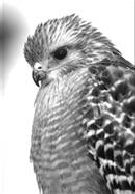by Bruce Swinehart

Wow! What is that noise? This is a comment often made by people hearing the shriek of the Red-shouldered Hawk. This bird is often heard long before it is seen sitting inside the branches of a tall tree rather than out near the edge. The shrill call is often described as “kee-yoo”.
It is perhaps not quite as easily distinguished as the Red-tailed Hawk with its very red tail. It is quite easily told, however, not by its red shoulders, but by its strikingly black and white banded tail edged in white at the end. The striped wings often show translucent crescent shaped “windows” (an ornithologist’s term) underneath. While the Red-tailed Hawk will glide for long periods without flapping its wings, the Red-shouldered Hawk will glide and flap, glide and flap. It is very characteristic. Its 16-inch body and 40-inch wingspan is a little smaller than the Red-tail.
A pair typically stays together all year. When you find one, there is most likely another. Some think they pair for life. They like to nest in taller trees along our creeks. The young do have the banded tail but lack the buffy color of the breast and wing linings.
The Red-shouldered Hawk is found in the Eastern United states and along the western edge of California, but is conspicuously missing from middle America. In days of yore when all hawks were considered bad, they were called the derogatory name, chicken hawks. The Red-shouldered Hawk helped give hawks a good name. They seem to eat mostly small things often found near water and along our creeks. Chickens are not much of its diet but mice, rats and squirrels are. Farmers could often observe this and recognize its value. Watch for it, it is a hawk you can positively identify on your own.
This article originally appeared in our Summer 2005 Newsletter
